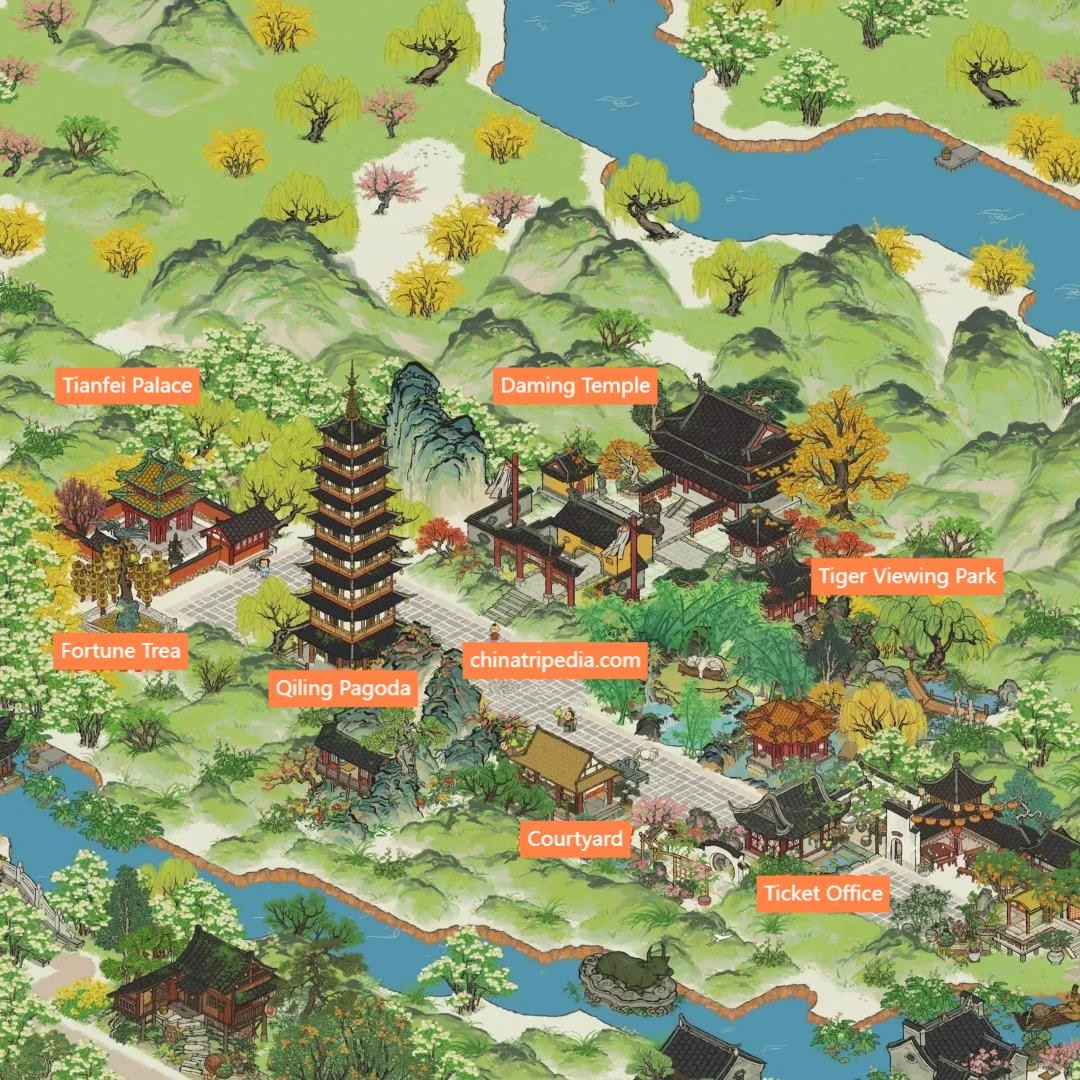Nestled on the serene peak of Shugang, at the northwest corner of the picturesque Slender West Lake in Yangzhou, China, Daming Temple (大明寺) has been a symbol of spiritual serenity for over a millennium. The temple, originally constructed during the Southern Dynasty, between 457 and 464 AD, takes its name from the era of Emperor Xiaowu of Song, known as the “Daming Era.”
The Daming Temple that stands today is a Qing Dynasty construction, built during the reign of Emperor Tongzhi. This place of worship has undergone various name changes throughout its history, such as “Qilingsi” and “Xisi” during the Sui Dynasty, and “Chengping” during the late Tang Dynasty. However, in 1980, the temple was officially restored to its original name, Daming Temple.
Daming Temple holds a unique place in history as it was where the renowned Tang Dynasty monk, Jianzhen, also known as Ganjin, transmitted Buddhist scriptures and administered ordinations before his momentous journey to Japan. The temple is divided into three distinct sections: the central core housing the main temple, the eastern section featuring the Qilin Pagoda, and the western part, an enchanting classical garden known as the West Garden. Visitors can explore the entirety of Daming Temple by following the sequence from the central to the eastern and western sections.
Table of Contents
- Basic Information
- Location and Transportation
- Map of Daming Temple
- Highlights of Daming Temple
- Vlog about Daming Temple
- A Brief History of Daming Temple
- Useful Tips Summarized from Reviews
- Attractions near Daming Temple
Basic Information
| Website | http://www.damingsi.com/ |
| Estimated Length of Tour | 2 hours |
| Ticket Price | 30 RMB (1st December – 28th February and 1st July – 31st August) 45 RMB (1st March – 30th June and 1st September – 30th November) |
| Qiling Pagoda | 26 RMB |
| Opening Hours | 8.00 – 16.30 |
| Telephone Number | 0086-0514-87357803 |
Location and Transportation
Daming Temple is situated on the northwestern outskirts of Yangzhou City, in Jiangsu Province, China. Specifically, it can be found at 8 Pingshan Tang East Road, Hanjiang District. To get there, tourists can take bus 25, 45, 72, Tourist Line 1, Tourist Line 2, or Tourist Line 3, and get off at Damingsi Stop (大明寺站).
Map of Daming Temple

Highlights of Daming Temple
Buddhist Architecture

As you enter the grand gates of Daming Temple, you’ll be greeted by the beautifully inscribed three characters “大明寺” (Daming Temple) above the main entrance. These characters were inscribed by Zhao Puchu, the Vice Chairman of the National Committee of the Chinese People’s Political Consultative Conference and the President of the Buddhist Association of China. The calligraphy exudes an ancient, elegant charm.

The main hall of the temple houses a statue of Maitreya Buddha, with the guardian deity Wei Tuo on the reverse side. Flanking the hall are the Four Heavenly Kings, known as the protectors of Buddhism: Dhritarashtra, Virudhaka, Virupaksha, and Vaishravana. Walking past the Hall of the Four Heavenly Kings, you’ll find yourself in a spacious courtyard with ancient, towering trees and the ever-present scent of incense wafting through the air.

The Hall of the Mahavira (Daxiong Baodian), constructed during the Qing Dynasty, is a three-bay wide, triple-eave structure with surrounding corridors and ornate ridge decorations. At the apex of the roof, there is an embedded precious mirror with the inscription “国泰民安” (National Peace and Prosperity) on the front and “风调雨顺” (Smooth Wind and Rain) on the back. Inside the hall, you’ll find a solemn atmosphere with Buddhist scriptures and instruments for religious ceremonies. In the center, enthroned on a lotus platform, is the majestic statue of Gautama Buddha.
Pingshan Hall

Pingshan Hall is an integral part of the Daming Temple complex, constructed during the Northern Song Dynasty by the famous scholar-official Ouyang Xiu when he served as the Prefect of Yangzhou. The hall overlooks a tranquil courtyard, featuring lush trees, providing a peaceful atmosphere for contemplation. The view from Pingshan Hall perfectly aligns with the distant mountains of Jiangnan, which is why it is aptly named “平山堂”. A couplet at the entrance reads: “Overlooking the mountains across the river from this hall, Prefect Ouyang feasted with his guests.” These lines capture the vibrant spirit of Ouyang Xiu’s time as the Prefect of Yangzhou. During Su Dongpo‘s tenure as the Prefect of Yangzhou, he frequented Pingshan Hall and, in honor of Ouyang Xiu, built the “Gulin Hall” and the “Ouyang Shrine” in the vicinity.
The West Garden

To the west of Pingshan Hall lies a classical garden of extraordinary beauty called the West Garden. Also known as the Imperial Garden (御苑) or the Fragrant Garden (芳圃), this garden was initially established in the first year of the Qing Dynasty’s Qianlong reign (1736). Unfortunately, it suffered damage during the Taiping Rebellion but was later reconstructed during the Tongzhi reign. The garden has undergone multiple renovations since 1949. Today, the West Garden boasts ancient, towering trees, intriguing rock formations, serene ponds, elegant pavilions, and a unique feature known as the “Fifth Spring in the World.” According to Zhang Youxin, a Tang-era writer, the spring water found in this garden was once acclaimed as the fifth best in the world. As visitors explore Daming Temple, drinking from the “Fifth Spring” remains a delightful tradition and a refreshing way to experience the temple’s spiritual and natural beauty.
Jianzhen Memorial Hall

The most distinctive feature of Daming Temple is the Jianzhen Memorial Hall. This hall was constructed in 1973 to commemorate the 1,200th anniversary of Jianzhen’s final Nirvana. Before undertaking his historic journey to Japan, Jianzhen served as the abbot of Daming Temple. Over a span of more than a decade, starting from the first year of the Tang Tianbao era (742), he made six perilous attempts to reach Japan. On his sixth and final attempt, he successfully brought Chinese Buddhism, medicine, language, literature, architecture, sculpture, calligraphy, and printing to Japan, making significant contributions to the cultural exchange between China and Japan.
Qilin Pagoda

The Qilin Pagoda, originally constructed in 601 AD, is another significant element of Daming Temple. Standing at nine stories tall, it reaches a total height of 70 meters. The pagoda enshrines relics of Sakyamuni and was one of most prominent temples in the region, Regrettably, during the Tang Dynasty in 843 AD, the pagoda was reduced to ashes due to warfare. In 1988, the head monk of Daming Temple, Ruixiang, chose a site in the temple’s eastern garden for the reconstruction of the Qilin Pagoda. By New Year’s Day in 1996, the reconstruction of the Qilin Pagoda was completed, restoring this precious cultural relic to its former glory.
Vlog about Daming Temple
A Brief History of Daming Temple
Daming Temple was originally established in 601 AD during the Sui Dynasty when Emperor Yang Jian ordered the construction of 30 pagodas nationwide to commemorate his birthday and enshrine Buddhist relics. As a result, the temple built the towering nine-story Qiling Pagoda, renowned as one of China’s most magnificent structures, giving the temple its alternate name, Qiling Temple.
During the Tang Dynasty, the famous monk Jianzhen (Ganjin) served as the abbot, making Daming Temple a key site in Sino-Japanese Buddhist relations. However, in 843 AD, the Qiling Pagoda was destroyed by fire. Though it was later rebuilt, it suffered repeated destruction over time.
In the Northern Song Dynasty, Ouyang Xiu, then governor of Yangzhou, constructed the Pingshan Hall within the temple. The temple underwent further renovations in the Ming Dynasty, with Yangzhou governor Wu Xiu rebuilding it during the Wanli reign, and Censor Yang Renyuan restoring it again in 1639. During the Qing Dynasty, particularly in the prosperous Kangxi and Qianlong periods, Daming Temple expanded significantly, becoming the most prestigious of Yangzhou’s eight major temples. However, in 1853, the Taiping Army set fire to the temple, reducing it to ruins. It was later rebuilt in 1870.
In modern times, the temple saw multiple restorations. In 1934 and 1944, renovations were carried out under the leadership of Wang Bailing and Master Changquan. After further repairs in the 1950s, it was designated a protected cultural site in 1957. During the Cultural Revolution, Zhou Enlai’s directive helped safeguard the temple from destruction. In 1973, the Jianzhen Memorial Hall was completed, and in 1980, the temple regained its original name, welcoming a statue of Jianzhen from Japan.
Useful Tips Summarized from Reviews
Panoramic Views from Qilin Tower: Qilin Tower, situated within Daming Temple, offers panoramic views of Yangzhou. From this vantage point on the seventh floor, visitors can enjoy a broad perspective that encompasses landmarks such as Slender West Lake, Daming Temple, and the surrounding scenery.
Value-Added Services on the Seventh Floor: After taking in the views from Qilin Tower, visitors can access additional services. One such option is the opportunity to participate in bell-ringing at the clock tower for an enhanced experience (priced at 25 yuan). The eighth floor houses the true relics of Shakyamuni Buddha, providing a close-up viewing opportunity.
Choosing the South Gate for Taxi Drop-off: If arriving by taxi, it’s recommended to set the destination to the South Gate. Some visitors reported difficulties finding the entrance when dropped off on the road, leading to a longer journey around the area.
Proximity to Slender West Lake: Daming Temple is conveniently located near the North Gate of Slender West Lake. Exiting from the North Gate, visitors can easily walk to Daming Temple.
Taste the Local Cuisine: Near the exit, there are positive reviews about the delicious vegetarian noodles (素面) available. Consider trying this local delicacy for a satisfying culinary experience.
Optional Zen Tea Performance: Daming Temple offers a Zen tea performance, depicting the life of Master Jianzhen. This additional experience requires a separate fee. However, many visitors felt it might not be worth the extra cost.








At 11:00, we arrived at Daming Temple. The Mahavira Hall was crowded, but once we dispersed to the areas on either side, especially towards the back mountain, there were hardly any people around. We passed by the Ouyang Shrine and the Qianlong Stele, following a small path to the Ship Hall Teahouse (船厅茶社) to see the black swans. Continuing our visit at Pingshan Hall, we then returned to the Qiling Pagoda and circled it twice. Tickets are available to take… Read more »
I entered Daming Temple an hour before closing and there weren’t many people. I strolled around and took some photos, but after an hour, my legs were tired. Climbing up the pagoda required an additional fee (in addition to the entrance ticket), so I decided to skip it.
Visiting Daming Temple in March is a must, especially for climbing the Qiling Tower. From the tower, you can enjoy a distant view of the Slender West Lake Scenic Area, overlook Guanyin Mountain, and see the Jianzhen Library – it’s truly delightful.
Personal Recommendations for Tourist Attractions in Yangzhou: Ge Garden; Slender West Lake; He Garden; Guanyin Mountain.
I do not recommend Daming Temple, the Grand Canal Museum, or Dongguan Street.
Daming Temple has a lot of commercialization; the Grand Canal Museum was overly crowded, possibly due to it being free, leading to long lines and lowered expectations; Dongguan Street was also very crowded, making it difficult to move forward in the throng of people.